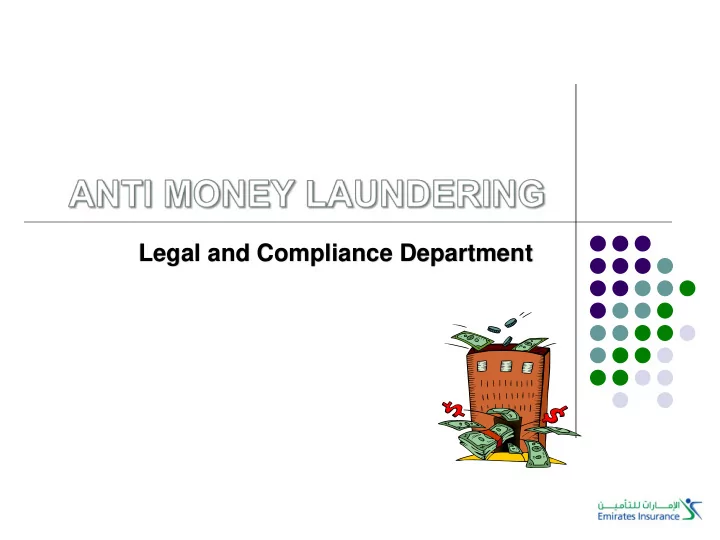

Legal and Compliance Department
Responsibilities Insurance Companies and staff Insurance companies and all persons working in the professions associated with the insurance business must maintain the documents and records pertaining to identifying their clients for a period not less than five years following the expiration date of the insurance policy and the reinsurance contract. In terms of harmonizing efforts and cooperation to counter money laundering and terrorist financing, the principle of due care and diligence was set when dealing with customers among which: 1. Customers that pay insurance premiums from accounts kept in countries that don’t have the legal frame work to counter money-laundering. 2. Customers that usually conduct business associated with precious goods, such as jewelry, gold, cars, antiquities, real estate and leasing. 3. Customers that travel on regular basis to countries known for trading and farming drugs. 4. Customers that don’t show care regarding the amount of the insurance premium or commissions or any other matter pertaining to the insurance coverage.
Why do we have to be concerned now? The main requirement supplied by the IA BOD No. (13) of 2015 concerning Instructions for Anti-money laundering and Countering Terrorist Financing, is the doctrine of Know Your Customer, which requires insurance companies to set the necessary procedures to acquire the relevant status and information about their customers, their assignees and the true beneficiaries of the natural and juridical persons. Insurance companies and all persons working in the professions associated with the insurance business must maintain the documents and records pertaining to identifying their clients for a period not less than five years following the expiration date of the insurance policy and the reinsurance contract.
WHAT IS MONEY LAUNDERING ? Legal / white Money Illegal / Dirty Money Conversion Definition: 'Money Laundering' is the process by which illegal funds and assets are converted into legitimate funds and assets.
Money Laundering generally refers to ‘washing’ of the proceeds or profits generated from: Drug Bribery Extortion Trafficking & Corruption Gambling, Criminal Smuggling Robbery, Activities (arms, people, Cheating goods) Counterfeiting & Forgery Terrorist Acts
Money Laundering Cycle: 1. Predicated Crimes 2. Placement • Corruption and Bribery • Initial introduction of criminal • Fraud proceeds into the stream of • Organized crime commerce • Drug and human trafficking • Most vulnerable stage of • Environmental crime money laundering process • Terrorism • Other serious crimes… 3. Layering 4. Integration Involves distancing the money from • The last stage in the laundering its criminal source of $: process. • into different accounts • Occurs when the laundered proceeds • movements of money to are distributed back to the criminal. different countries • Creates appearance of legitimate • Increasingly difficult to detect. wealth.
How can Money be laundered through insurance companies? Examples 1 There are a number of ways that launderers can use insurance products. The following cases may indicate money laundering: • Paying a large “top - up” into an existing life insurance policy. • Purchasing a general insurance or motor policy, then making a claim soon after. • A customer who usually purchases small policies, suddenly requests a large lump-sum contract. • A customer who wishes to fund its policy using payments from a third party. • Purchasing one or more single-premium investment-linked policies, then cashing them in a short time later. • Premiums being paid into one policy, from different sources.
How can Money be laundered through insurance companies? Examples 2 • Making over-payment on a policy, then asking for a refund. • Where the relationship between the policyholder and beneficiary seems unusual. • “Structuring” – i.e. purchasing several policies just under the reportable limit, instead of purchasing one large policy (in some countries all transactions over a certain limit must be reported to the Government). • Where the customer is more interested in learning about cancellation terms than about the benefits of the policy. • Unusually large payments using cash, money order or travelers cheques. • Redemption of a policy which is unusually early or does not make good economic sense. • Channeling payments via offshore banks.
How can Money be laundered through insurance companies? Examples 3 • Customers that pay insurance premiums from accounts kept in countries that don’t have the legal frame work to counter money-laundering. • Customers that usually conduct business associated with precious goods, such as jewelry, gold, cars, antiquities, real estate and leasing. • Customers that travel on regular basis to countries known for trading and farming drugs. • Customers that don’t show care regarding the amount of the insurance premium or commissions or any other matter pertaining to the insurance coverage.
Amounts of Cash • <Aed25 000, no action required • >Aed25 000< Aed40 000, browse the Sanctions report. Link on EIC Website under Anti Money laundering Section. This link will take you to Consolidated United Nations Security Council Sanctions List • >Aed40 000 as above but also complete Suspicious Transaction Report, obtainable from our website. http://www.eminsco.com/stakeholders/anti-money-laundering-policy/ • Forward the report to Money Laundering Officer (Mazen Mahmood)
What happens if individual is on list? Reporting to the Unit on Suspicious Transactions The relevant employees must freeze the transaction and the EIC Money Laundering Officer should be informed in case of the existence of an admissible doubt in any insurance operation used to launder money. When unable to identify the customer using a trustworthy source of information, the Employee in charge must: • Immediately terminate any relationship with the client and report to the reporting manager. • The reporting manager will submit a Suspicious Transaction Report to the Anti Money Laundering Officer (Legal & Compliance Department)
Money Laundering Flow Chart
Confidentiality All insurance companies and persons working in the professions associated with insurance must deal with the information they possess in confidentiality and must not reveal them except with the necessary portion of such for the use of investigations or lawsuits, taking into consideration the applicable laws in the state.
Recommend
More recommend